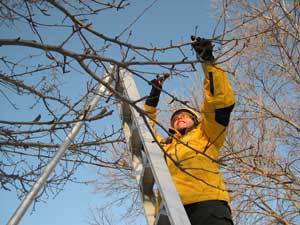
The pruning season officially starts at the New Year, so let’s begin 2014 with pruning shears in hand! Pruning is an important garden task, but because of its surgical aspect it can be daunting for many gardeners. This article features pruning basics to help those who might be afraid to take that initial snip. Your plants more than likely will grow out of any pruning mistakes inflicted upon them; so, prune away!
Wait to prune back spring blooming shrubs like forsythia, lilac, quince, azalea and rhododendron. Enjoy their spring bloom; then prune your spring bloomers just after the last flowers drop. Focus on cutting back fruit trees, perennial shrubs, and summer bloomers.
Most pruning books advise that 10% of a plant’s foliage mass can be cut back any time of the year. This means pruning a slight haircut for most hedges, or removing a major tree limb encroaching on a sidewalk. Major pruning is completed in mid winter, January through March. Up to 1/3 of the foliage mass of trees and shrubs can be trimmed back during this season. Any more than that invites disease, insects, and a stressful environment for plants.
This is the time to cut back all summer blooming perennial shrubs like butterfly bush, Russian sage, and rose of Sharon. All of them will enjoy a winter haircut. Roses are pruned back in the month of March. With these quick guidelines in mind, let’s go through my pruning guide.
Remove stakes and guy wires installed with trees planted over a year ago. Prune out dead or damaged branches. Dead wood not only looks ugly, but it attracts insects, disease, and wood-pecking birds. Thin out branches on trees with histories of disease or mildew. Reducing the mass of branches will improve air circulation and penetration of sunlight, which in turn reduces the incidence of disease. Plums, cherries, peaches, willows, and poplars are prone to leaf problems and really benefit from this pruning.
 I like to have every tree in my landscape pruned to at least 6’2″ from the ground. I choose that exact height because I don’t like to ding my forehead when walking under my trees. Some trees take several years before they finally reach the height I like; by cutting a few branches each year I soon have trees with my desired clearances. Maybe your trees need to be much higher or just at 5’10” from ground level. Make it comfortable for you to clean, work, and play under your trees.
I like to have every tree in my landscape pruned to at least 6’2″ from the ground. I choose that exact height because I don’t like to ding my forehead when walking under my trees. Some trees take several years before they finally reach the height I like; by cutting a few branches each year I soon have trees with my desired clearances. Maybe your trees need to be much higher or just at 5’10” from ground level. Make it comfortable for you to clean, work, and play under your trees.
There are two techniques for pruning the remaining branches on trees and shrubs: heading and thinning. Heading is cutting a branch back to a healthy bud that is pointing in the direction you want the plant to grow. This method is used mainly on evergreen shrubs, hedges, and roses.
Thinning is completely removing a shoot or branch either to ground level or to another main branch or trunk. No prominent stub remains. This is usually the best method for pruning trees. I don’t have space here for how-to sketches showing these proper cuts but my handout “Pruning Basics” has photos that really are helpful. Just click on this link or ask for it the next time you visit the garden center: Pruning-Basics.pdf
When pruning is completed trees are ready for a winter application of All Season Oil. This winter application effectively kills insects and their eggs, yet is safe for plants, birds, and our environment. All Season Oil is especially important for young trees or trees that had problems last year with insects or disease. All fruit trees should be sprayed to increase chances of a worm-less crop this spring.
The trunks of young trees with small canopies and thin barks should be painted white to prevent sunscald. This is especially important for fruit trees and larger shades trees like ash and maple.
~~ ~~ ~~ ~~ ~~ ~~ ~~
 EXCITING NEWS! The FoxFarm Soil and Fertilizer Company is nationally renowned for its soil science and high grade plant foods, especially for hydroponic, greenhouse, and indoor plant gardens. Don Anderson is FoxFarm’s western region manager. Unsure that such a talent would accept my invitation, I asked Don to teach a class for local gardeners, and he agreed! He will be here next Saturday! So, on January 11th at 9:30a.m. Don will teach our gardening class entitled “Where Inspiration Begins, Starting & Growing Plants Indoors.” Whether you want info about starting seed or just want healthier production from your indoor plants this class is for you. Even if it weren’t free, our greenhouse will be packed for this class; so bring a lawn chair and your favorite cup of coffee and join us at Watters Garden Center.
EXCITING NEWS! The FoxFarm Soil and Fertilizer Company is nationally renowned for its soil science and high grade plant foods, especially for hydroponic, greenhouse, and indoor plant gardens. Don Anderson is FoxFarm’s western region manager. Unsure that such a talent would accept my invitation, I asked Don to teach a class for local gardeners, and he agreed! He will be here next Saturday! So, on January 11th at 9:30a.m. Don will teach our gardening class entitled “Where Inspiration Begins, Starting & Growing Plants Indoors.” Whether you want info about starting seed or just want healthier production from your indoor plants this class is for you. Even if it weren’t free, our greenhouse will be packed for this class; so bring a lawn chair and your favorite cup of coffee and join us at Watters Garden Center.
Gardening Classes – Our free gardening classes begin this week. The morning of Saturday, January 4th at 9:30 will find us in one of the garden center’s greenhouses ready to begin our 2014 gardening cycle. The series kicks off with “Advanced Landscape Pruning to Spring Success”. For your convenience, the entire spring schedule is at wattersgardencenter.com/category/classes.
Until next week, I’ll see you in the garden center.


I keep forgetting when to cut my rose bushes back. Is it too late now.
We are located in Northern AZ and usually tell our customers March is the best time.